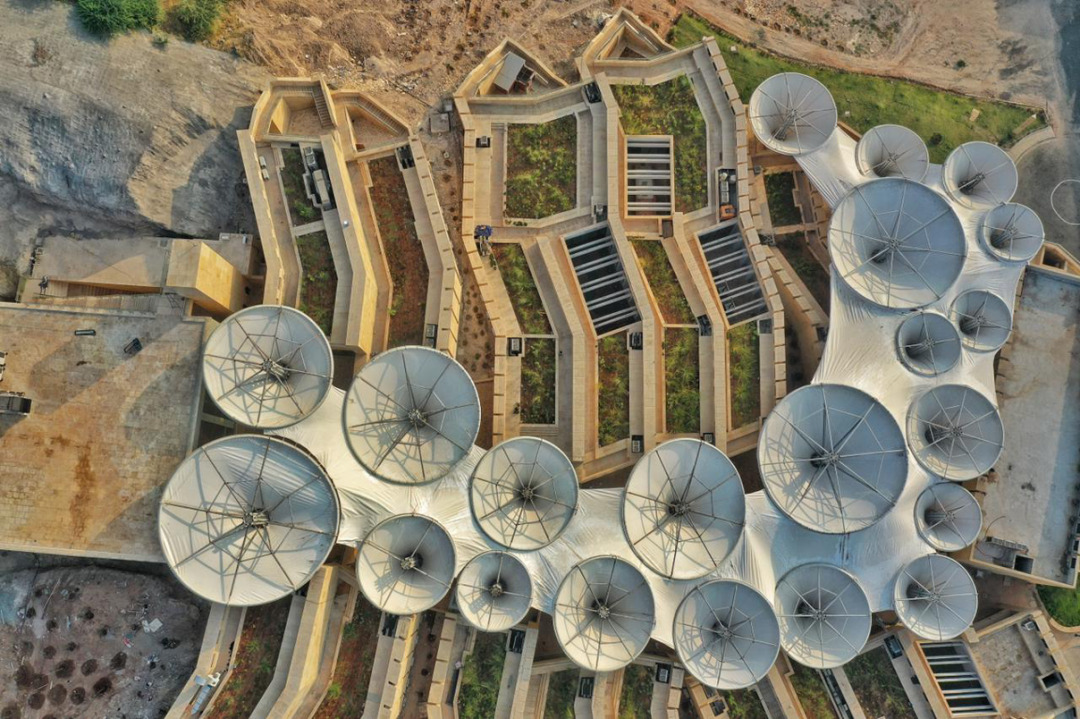

设计单位 Vastushilpa Sangath LLP
项目地点 印度普杰市
建成时间 2023年
占地面积 19100平方米
2001年1月26日,在印度古吉拉特邦发生的大地震夺走了万余人的生命,造成了数以十亿计的财产损失,给人们带来无法磨灭的创伤。在努力从地震造成的破坏中恢复过来的同时,人们也没有忘记遇难者。为了纪念地震遇难者,Vastushilpa Sangath LLP受委托做了Smritivan地震纪念馆的总体规划。
At 8:46 am on January 26, 2001, an earthquake occurred in the Kutch region of Gujarat. Measuring 7.6 on the Richter scale, it irrevocably shook innumerable lives and killed 13,805 people. The destruction of habitat, property and infrastructure ran in billions. The trauma it caused cannot truly be mapped.


——
Smritivan地震纪念碑
在干旱地区培育生命
“我们只需要在初始阶段,采取切实行动去帮助地球,之后的事交给自然就好。”
"We earnestly believe it is only necessary to initially assist the earth, till the new initiative takes root and then nature takes over. "
卡奇地区自然气候变化无常,长期遭受自然灾害,包括飓风、干旱等,这至少可以追溯到至今约4500年的印度河流域文明时期;因此,该地区已经演化出一定的抗逆能力。同时,这里水资源奇缺,其生态、经济、文化、社会结构和生存斗争等都围绕着这一元素。
Kutch is familiar with the vagaries of nature. It traces its roots at least to the Harappan civilization, thus at least 4500 years. In this period, it has been subject to numerous natural disasters, including cyclones and droughts. Consequently, it has evolved a culture of resilience. Water remains the scarcest natural resource, and so, the region’s ecology, economy, culture, social structure, festivals and struggle for survival all revolve around water.



当时的古吉拉特邦首席部长,也就是现在的总理莫迪对设计有一个简单而明确指示——“为每个受害者种一棵树”。树象征着重生、更新和希望,也象征着生命旅程的再次开始。同时,种植树木也代表了多元化和包容性社区的形成,就像由许多不同物种组成的森林一样。
The precise brief by the then Chief Minister of Gujarat, now Prime Minister, Narender Modi was to “plant a tree for each victim.” A simple yet profound brief. For a tree symbolizes rebirth, renewal and hope, the beginning of the journey of life once again. How better to commemorate the loss of human life than through such a symbolic act of regeneration? The planting of trees also suggested the making of a forest. The forest also symbolizes a collective that is made of many that are diverse.


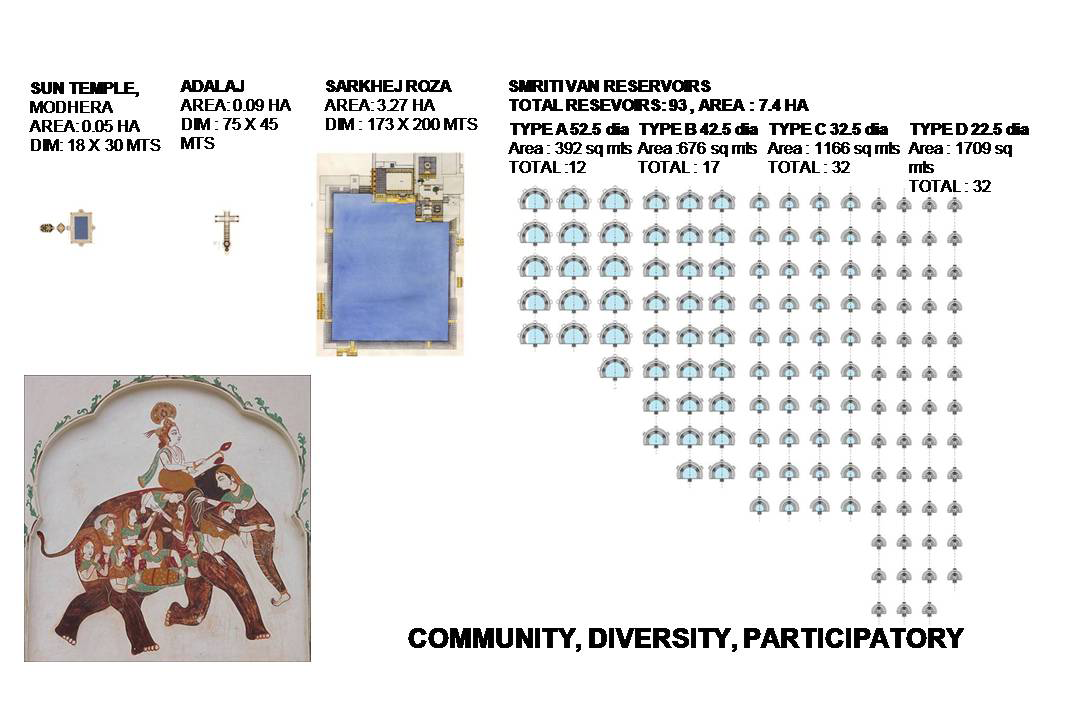
考虑到这一点,设计构想了两种相互关联的方法:一种是为了那些来缅怀他们亲人的遇难者家属,另一种则侧重于培育树木,为干旱地区提供复原力。设计采取的新举措包括:识别当地物种、确定水流路径、评估土壤成分和营养物质,以及最重要的是,设计水可以缓慢渗入地球的水箱和区域。基于此,团队将在这片占地452英亩的干旱土地上建立了一系列小型水库。该设计的第一阶段占地约199英亩,现已实施。
For us, this suggested two intertwined paths. One for the families of the victims who would come as pilgrims to remember their loved ones and the other, a path of sustenance of the trees, of resilience in an arid place such as Kutch. The assistance involved the identification of local species, the paths through which water flows, as well as the soil and nutrients that the water collects on its journey and most importantly thee design of the tanks and places where the water could seep into the earth slowly. The design then evolved by strategically planning small-scale reservoirs on the 452 acres. The first phase of about 199 acres has now been executed.
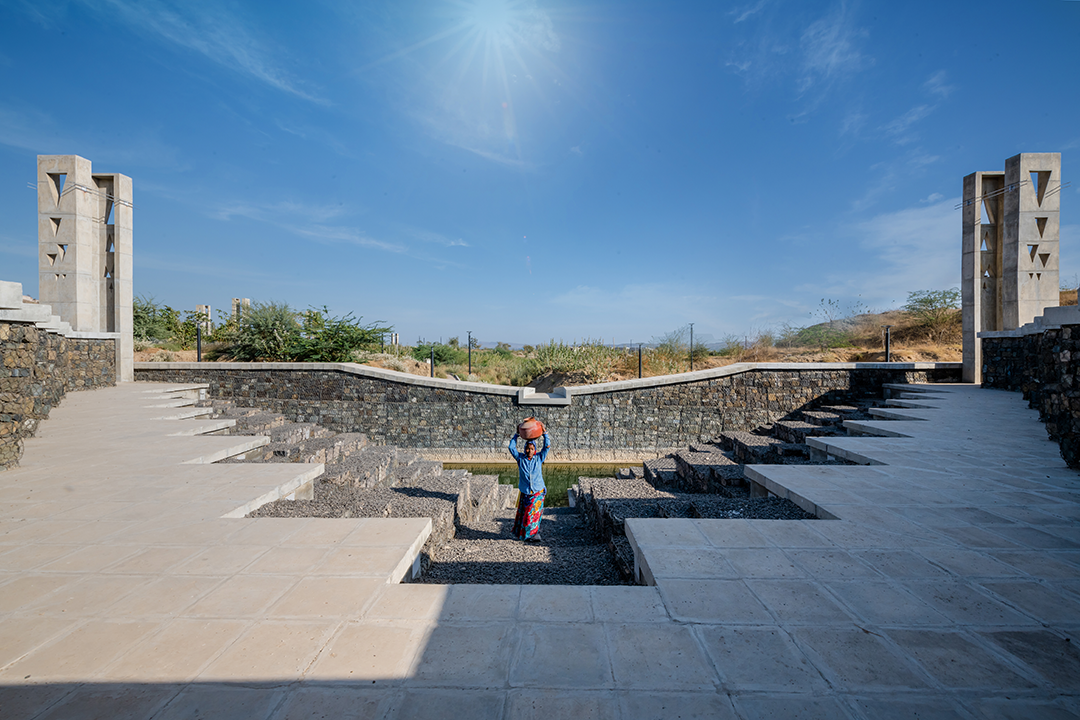




随着时间的推移,环境将会慢慢生长并形成郁郁葱葱的绿色景观,人们到此的体验也将发生变化。多样化的动植物群将发展成为一个与建筑形式无缝融合的生态系统,并将它们围合在一个由绿色植物和水组成的有凝聚力的迷宫之中。这样一来,这里将不仅仅是一个静态的纪念场所或花园,而将承载一段活生生的记忆,并对卡奇地区坚韧和希望的致敬。
As nature heals and cultivation grows, the experience of the memorial, of Smritivan changes. Slowly the diverse vegetation will grow into an ecosystem that will merge with the built forms, thus eventually engulfing them into one cohesive maze of green and blue. Smritivan is then neither a monolithic memorial nor a garden, but a living memory, and homage to the hope and resilience of Kutch.


此外,这里也旨在成为一个吸引人的公共空间。因此除了水库外,设计在山顶还建造了一个太阳点(sun point)。它为游客提供了城镇一览无余的景色,并鼓励人们沉思。它同时作为阴阳日历,记录了太阳和月亮的运动,通过圆环上的不同切口标记具有文化意义的重要节日。这种与宇宙的联系,提醒着人们地球之外的更大的宇宙事件。
Lastly, Smritivan is meant to be an engaging public space. Thus, along with the reservoirs, a sun point was also created. Located at the top of the hill, it offers vistas of the town that invite reflection. It charts the movement of the sun and moon in the form of a lune-solar calendar, with different cuts in the circular ring marking days of cultural significance. Thus, relating one to the cosmic, reminding one of the larger cosmic event one temporarily inhabits.
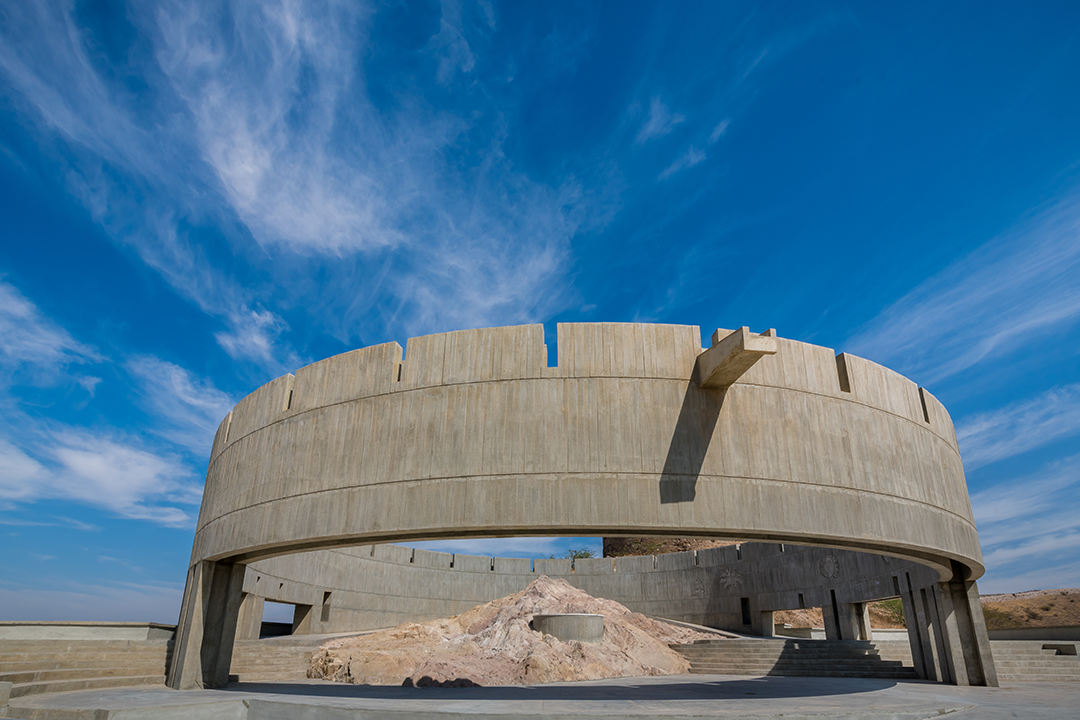


——
Smritivan地震博物馆
从崎岖地形中寻找线索
“行走对于一个地方的形成至关重要,它促使我们以独特的方式将建筑与周围环境联系起来。”
"We, as architects, strongly believe that walking is essential to the making of a place, as it enables us to connect to our surroundings in a unique way."
博物馆位于bhujiyo山顶上,设计将结合普杰市和卡奇县地区独特的遗产、文化、手工艺及当地许多村庄和野生动物保护区,其意图不仅仅是打造一个博物馆,而是提供一个公共空间,市民可以在此聚集、庆祝许多节日。这里还满足了城市对绿地和公园的需求,提高了社区的生活方式。博物馆的画廊则追溯了卡奇地区的各种工艺和技能,反映博物馆多样化的规划布局。
The museum is located in Bhuj, Gujarat, India on the bhujiyo hill. The museum is a part of the larger smritivan earthquake memorial masterplan, which was made to commemorate the 2001 earthquake of which Bhuj was the epicentre. The museum anchors its journey in the city of Bhuj and the Kutch region’s unique heritage, culture, crafts, and its many villages and wildlife sanctuaries. The design intent was to create not just a museum but a civic space where the citizens could gather and celebrate their many festivals and more. As with our other projects, we recognise the larger role of such institutions in the making of a city, and ensure that architecture contributes to civic life. The same was true for the Smritivan memorial which also addressed the need for a green lung and park for the city. Programmatically, the various galleries of the museum trace the various crafts and skills of the Kutch region.


bhujiyo山是当地文化遗产的一部分,其陡峭的坡度,意味着设计必须在不干扰景观的情况下,敏感地处理场地关系。因此,建造一个相对突兀的“大盒子”是不合适的;相反,山的自然轮廓提供了设计灵感。建筑的形式让人联想到堡垒城墙的遗迹,设计模仿人类或动物爬山的自然方式,或沿着朝圣路线前往圣地时所走的自然路径,将建筑沿着山坡的轮廓线呈“之”字形布置。
The steep slope of the hill meant one had to find a way to sensitively place a building that does not disturb the landscape. The hill is part of the cultural patrimony of the people. Hence building a large-scale box that would contrast with the hill was considered inappropriate. Rather, the contours inform an alternative approach. It dictated a form that recalls the relic of the fort wall which exists on this hill. The built mass is like a line that traces the contours as it zig-zags its way up the hill. It is the natural way that an animal or human uses to climb a hill, or as a pilgrimage route to a holy site.
项目“灵魂”在于缓慢地攀登,50米的蜿蜒旅程中穿插着7个不同主题的画廊。博物馆的中心“脊柱”是一个公民空间,即使在画廊关闭时也能运作。它为游客提供平台,供其流连、思考和探索景观。这些平台覆盖着从现场附近开采的当地石材,顶部的拉伸结构为整体建筑引入了柔和的光照。
The “soul” of the museum is then this slow climb, a peripatetic journey of a 50m climb punctuated by the various galleries. The spine acts like a veranda where one can pause, reflect and absorb the landscape. This tensile structure also creates a soft glow over the monolithic buildings which are covered in a local stone quarried from near the site. Overall, this central spine of the museum a civic space that operates when the galleries aren’t open.


时间性仍然是博物馆设计的核心。每个画廊的屋顶都种植了不同种类的本土植物,随着季节的变化而变化,融入周边山体,标志着时间的流逝。这些花园也承载着不同的功能,如临时展览和表演,这对博物馆来说至关重要。
Temporality remains central to the museum. Thus, each of the galleries’ rooftops is planted with different species of local flora which, as in the hill, changes with the seasons and mark the passage of time. These gardens also host different functions such as temporary exhibits and performances, which enables one to reflect and assimilate, something that is essential to such a museum.
此外,博物馆设计也考虑到了未来发展的需求。画廊的模块化和中心“脊柱”的轨迹,使得任何扩展需求都能始终保持这个地方的独特。因此,这个博物馆不仅将保留普杰市历史悠久的过去,也将编织新的记忆。
Like most settlements on a landscape, the museum is designed for incremental growth. The modularity of the galleries and the trace of the central spine is such that any extension will always remain aligned to the genius of the place. It is then a settlement, as old as Bhuj, and as young as the memory of the last visit.

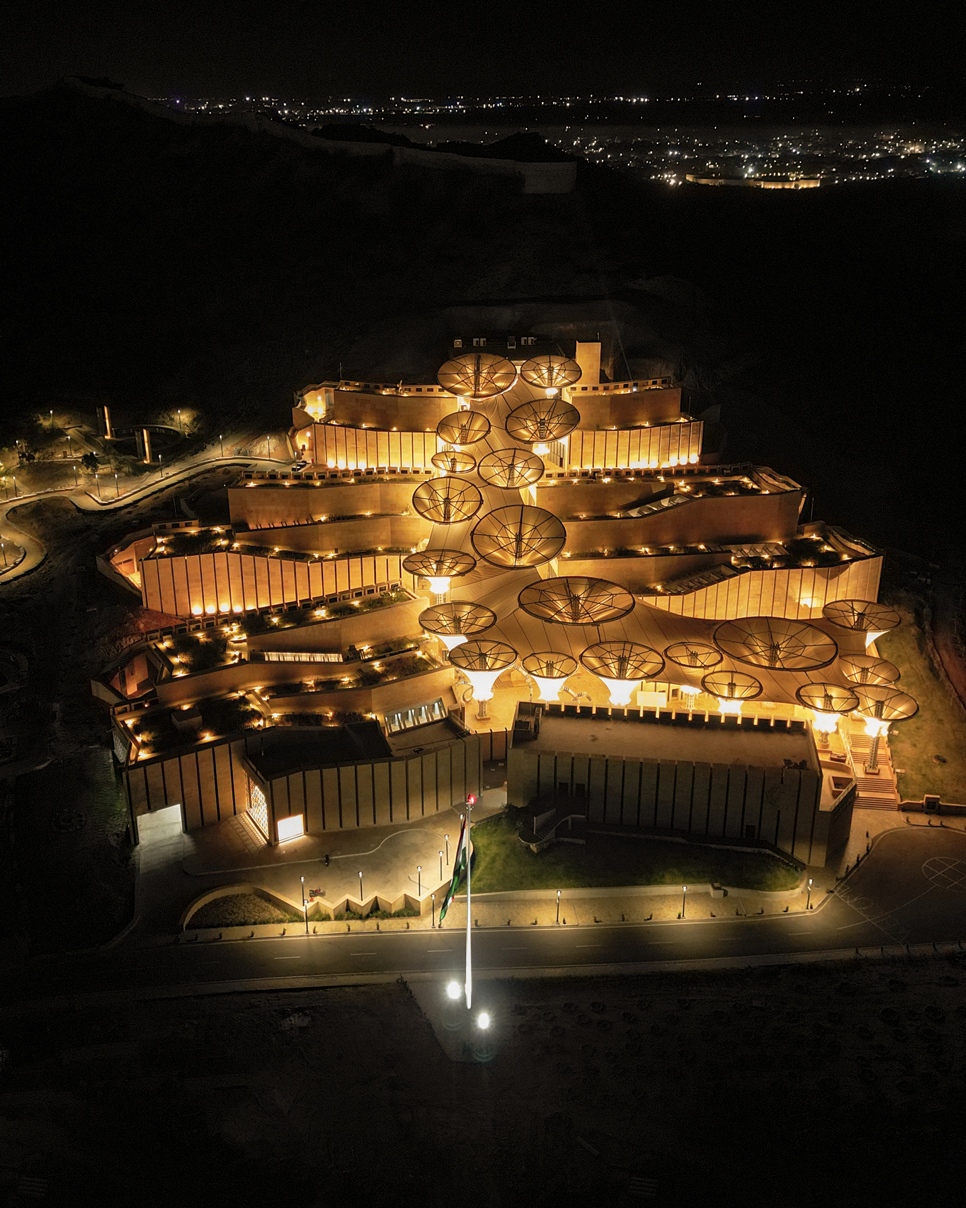
完整项目信息
Smritivan Earthquake Memorial & Museum
Architects: Vastushilpa Sangath LLP
Area: 19100 sqm
Location: Bhuj, Gujarat, India
Year: 2023
Photographs: Vinay Panjwani, Sohaib Ilyas
本文由Vastushilpa Sangath LLP授权有方发布。欢迎转发,禁止以有方编辑版本转载。
上一篇:经典再读200 | 联合国总部:对立的平衡
下一篇:中建西南院新作:大田上的风景,天府农博园青苗项目